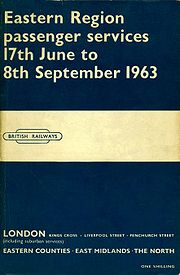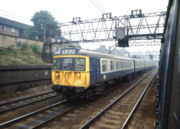
Eastern Region of British Railways
Encyclopedia

British Rail
British Railways , which from 1965 traded as British Rail, was the operator of most of the rail transport in Great Britain between 1948 and 1997. It was formed from the nationalisation of the "Big Four" British railway companies and lasted until the gradual privatisation of British Rail, in stages...
ways from 1948. The region ceased to be an operating unit in its own right in the 1980s and was wound up at the end of 1992. Together with the North Eastern Region
North Eastern Region of British Railways
The North Eastern Region was a region of British Railways from 1948. It was merged with the Eastern Region in 1967. It was the near direct post-nationalisation descendant of the North Eastern Railway, that had merged with the LNER just over 20 years early....
(which it absorbed in 1967), it covered most lines of the former London and North Eastern Railway
London and North Eastern Railway
The London and North Eastern Railway was the second-largest of the "Big Four" railway companies created by the Railways Act 1921 in Britain...
, except in Scotland
Scotland
Scotland is a country that is part of the United Kingdom. Occupying the northern third of the island of Great Britain, it shares a border with England to the south and is bounded by the North Sea to the east, the Atlantic Ocean to the north and west, and the North Channel and Irish Sea to the...
.
History
The region was formed in at nationalisation in 1948, mostly out of the former Great NorthernGreat Northern Railway (Great Britain)
The Great Northern Railway was a British railway company established by the Great Northern Railway Act of 1846. On 1 January 1923 the company lost its identity as a constituent of the newly formed London and North Eastern Railway....
, Great Eastern
Great Eastern Railway
The Great Eastern Railway was a pre-grouping British railway company, whose main line linked London Liverpool Street to Norwich and which had other lines through East Anglia...
and Great Central
Great Central Railway
The Great Central Railway was a railway company in England which came into being when the Manchester, Sheffield and Lincolnshire Railway changed its name in 1897 in anticipation of the opening in 1899 of its London Extension . On 1 January 1923, it was grouped into the London and North Eastern...
lines that were merged into the LNER in 1923.
Of all the "Big Four" pre-nationalisation railway companies, the LNER was most in need of significant investment. In the immediate post-war period there was a need to rebuild the destroyed stations in London and along the busy East Coast Main Line and former Great Central Railway
Great Central Railway
The Great Central Railway was a railway company in England which came into being when the Manchester, Sheffield and Lincolnshire Railway changed its name in 1897 in anticipation of the opening in 1899 of its London Extension . On 1 January 1923, it was grouped into the London and North Eastern...
. Additionally, the LNER had begun a suburban electrification
Railway electrification in Great Britain
Railway electrification in Great Britain started towards of the 19th century. A great range of voltages have been used in the intervening period using both overhead lines and third rails, however the most common standard for mainline services is now 25 kV AC using overhead lines and the...
programme which the British Transport Commission
British Transport Commission
The British Transport Commission was created by Clement Attlee's post-war Labour government as a part of its nationalisation programme, to oversee railways, canals and road freight transport in Great Britain...
was pledged to continue. It was partially for this reason that the former LNER in England was divided into Eastern and North Eastern regions to focus investment, unlike the other English and Welsh regions that wholly took over their respective former companies' lines. In 1967 this policy was reversed and North Eastern was merged with the Eastern region.
Over the years the region was recast to be geographical rather than being based upon pre-nationalisation ownership. In 1949 the Eastern Region gained the London Tilbury and Southend
London, Tilbury and Southend Railway
The London, Tilbury and Southend Railway is an English railway line linking Fenchurch Street railway station in the City of London with northeast London and the entire length of the northern Thames Gateway area of southern Essex. It is currently known as the Essex Thameside Route by Network Rail...
lines from the London Midland Region
London Midland Region of British Railways
The London Midland Region was one of the six regions created on the formation of the nationalised British Railways and consisted of ex-London, Midland and Scottish Railway lines in England and Wales. The region was managed first from buildings adjacent to Euston Station and later from Stanier...
. In a major national boundary change in 1958 the former Great Central network except those lines in Yorkshire
Yorkshire
Yorkshire is a historic county of northern England and the largest in the United Kingdom. Because of its great size in comparison to other English counties, functions have been increasingly undertaken over time by its subdivisions, which have also been subject to periodic reform...
and Lincolnshire
Lincolnshire
Lincolnshire is a county in the east of England. It borders Norfolk to the south east, Cambridgeshire to the south, Rutland to the south west, Leicestershire and Nottinghamshire to the west, South Yorkshire to the north west, and the East Riding of Yorkshire to the north. It also borders...
transferred to the London Midland Region; in return the Eastern gained the former LMS lines in Lincolnshire
Lincolnshire
Lincolnshire is a county in the east of England. It borders Norfolk to the south east, Cambridgeshire to the south, Rutland to the south west, Leicestershire and Nottinghamshire to the west, South Yorkshire to the north west, and the East Riding of Yorkshire to the north. It also borders...
and the present-day South Yorkshire
South Yorkshire
South Yorkshire is a metropolitan county in the Yorkshire and the Humber region of England. It has a population of 1.29 million. It consists of four metropolitan boroughs: Barnsley, Doncaster, Rotherham, and City of Sheffield...
. In the 1960s the Eastern became one of the regions most affected by the Beeching Axe
Beeching Axe
The Beeching Axe or the Beeching Cuts are informal names for the British Government's attempt in the 1960s to reduce the cost of running British Railways, the nationalised railway system in the United Kingdom. The name is that of the main author of The Reshaping of British Railways, Dr Richard...
, losing route miles in every county served and seeing the closure of previously important (but "duplicate") lines such as Harrogate to Northallerton via Ripon.

Network
The main routes were:- Liverpool Street stationLiverpool Street stationLiverpool Street railway station, also known as London Liverpool Street or simply Liverpool Street, is both a central London railway terminus and a connected London Underground station in the north-eastern corner of the City of London, England...
and the former GER eastern mainline to Shenfield, Colchester and Harwich in EssexEssexEssex is a ceremonial and non-metropolitan county in the East region of England, and one of the home counties. It is located to the northeast of Greater London. It borders with Cambridgeshire and Suffolk to the north, Hertfordshire to the west, Kent to the South and London to the south west...
, Norwich in NorfolkNorfolkNorfolk is a low-lying county in the East of England. It has borders with Lincolnshire to the west, Cambridgeshire to the west and southwest and Suffolk to the south. Its northern and eastern boundaries are the North Sea coast and to the north-west the county is bordered by The Wash. The county...
and Ipswich and Felixstowe in SuffolkSuffolkSuffolk is a non-metropolitan county of historic origin in East Anglia, England. It has borders with Norfolk to the north, Cambridgeshire to the west and Essex to the south. The North Sea lies to the east...
. - Liverpool Street station and the former GER western mainline to CambridgeCambridgeThe city of Cambridge is a university town and the administrative centre of the county of Cambridgeshire, England. It lies in East Anglia about north of London. Cambridge is at the heart of the high-technology centre known as Silicon Fen – a play on Silicon Valley and the fens surrounding the...
and King's LynnKing's LynnKing's Lynn is a sea port and market town in the ceremonial county of Norfolk in the East of England. It is situated north of London and west of Norwich. The population of the town is 42,800....
(Norfolk). - London King's Cross railway station to Stevenage in HertfordshireHertfordshireHertfordshire is a ceremonial and non-metropolitan county in the East region of England. The county town is Hertford.The county is one of the Home Counties and lies inland, bordered by Greater London , Buckinghamshire , Bedfordshire , Cambridgeshire and...
and Peterborough in CambridgeshireCambridgeshireCambridgeshire is a county in England, bordering Lincolnshire to the north, Norfolk to the northeast, Suffolk to the east, Essex and Hertfordshire to the south, and Bedfordshire and Northamptonshire to the west...
. - Fenchurch Street railway stationFenchurch Street railway stationFenchurch Street railway station, also known as London Fenchurch Street, is a central London railway terminus in the south eastern corner of the City of London, England. The station is one of the smallest terminals in London in terms of platforms and one of the most intensively operated...
to Basildon (from 1974), Southend and Shoeburyness.
The lines were managed as the Great Northern (Kings Cross services) and the Great Eastern (Liverpool Street and Fenchurch Street services), with the regional headquarters at 55 Liverpool Street. After the merger with the North Eastern Region, that region's headquarters in York
York
York is a walled city, situated at the confluence of the Rivers Ouse and Foss in North Yorkshire, England. The city has a rich heritage and has provided the backdrop to major political events throughout much of its two millennia of existence...
became the headquarters of the new Eastern Region.
Commuter services via the North London Line were also run into Broad Street station, but these were slowly run down and diverted to other destinations, with the station eventually being closed in 1986.
Electrification

Railway electrification in Great Britain
Railway electrification in Great Britain started towards of the 19th century. A great range of voltages have been used in the intervening period using both overhead lines and third rails, however the most common standard for mainline services is now 25 kV AC using overhead lines and the...
, using the then-standard 1500V overhead DC system, in the London suburbs, allowing for the removal of steam services from Essex by the mid-1950s, and on the busy Woodhead route between Manchester and Sheffield
Manchester-Sheffield-Wath electric railway
The Manchester-Sheffield-Wath electric railway was an early electrification scheme on British railways. The route featured long ascents on both sides of the Pennines with the long Woodhead Tunnel at its central summit close to the Woodhead pass...
. The original plan had called for the eventual electrification of most of the LNER, and the Eastern Region sought to continue this policy as part of the 1955 Modernisation Plan. However, the British Transport Commission felt that many Eastern Region routes would not benefit from this; indeed, many of the rural lines proposed for electrification were in fact closed entirely by Dr Beeching. Instead, the Eastern Region had to content itself with being an early adopter of diesel-electric power, replacing steam at the earliest opportunity.
The premier East Coast Main Line was not electrified throughout until the late 1980s, by which time the Eastern Region had been abolished with the coming of sectorisation.

